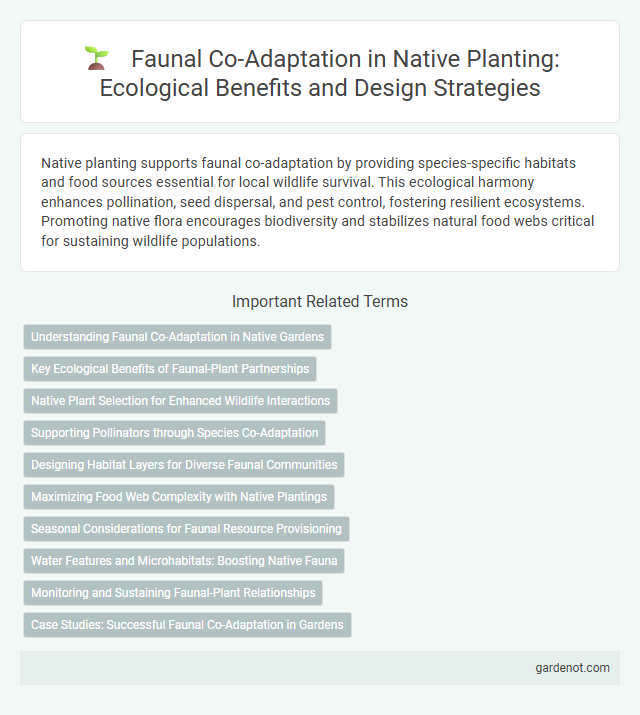Native planting supports faunal co-adaptation by providing species-specific habitats and food sources essential for local wildlife survival. This ecological harmony enhances pollination, seed dispersal, and pest control, fostering resilient ecosystems. Promoting native flora encourages biodiversity and stabilizes natural food webs critical for sustaining wildlife populations.
Understanding Faunal Co-Adaptation in Native Gardens
Faunal co-adaptation in native gardens refers to the mutual evolutionary relationships between native plants and local wildlife, including pollinators, herbivores, and predators. Understanding these interactions enhances ecosystem stability, promotes biodiversity, and supports native species populations by providing tailored habitats and food sources. Native planting that considers faunal co-adaptation optimizes ecological balance, improving garden resilience and sustainability.
Key Ecological Benefits of Faunal-Plant Partnerships
Faunal co-adaptation enhances biodiversity by fostering mutualistic relationships between native plants and wildlife, which improve pollination, seed dispersal, and nutrient cycling. These partnerships support ecosystem resilience, enabling habitats to recover from disturbances and sustain diverse animal populations. Effective faunal-plant interactions promote balanced food webs and stabilize local microclimates, crucial for long-term ecological health.
Native Plant Selection for Enhanced Wildlife Interactions
Selecting native plants that have co-evolved with local fauna enhances ecological balance and promotes habitat suitability for pollinators, birds, and beneficial insects. Native species such as milkweed support monarch butterflies by providing essential breeding grounds, while oak trees offer acorns that sustain diverse wildlife populations. This strategic plant selection fosters mutualistic relationships, boosting biodiversity and ecosystem resilience.
Supporting Pollinators through Species Co-Adaptation
Native planting enhances faunal co-adaptation by fostering mutualistic relationships between indigenous plants and local pollinators, ensuring effective pollination and ecosystem stability. Species co-adaptation supports specialized pollinators such as native bees, butterflies, and hummingbirds, which rely on the specific floral traits of native plants for nectar and reproduction. This ecological synergy enhances biodiversity, promotes resilient habitats, and sustains long-term pollination services critical for native plant reproduction and food webs.
Designing Habitat Layers for Diverse Faunal Communities
Designing habitat layers with native plants creates structural complexity that supports diverse faunal communities by providing food, shelter, and breeding sites tailored to specific species' needs. Integrating ground cover, shrubs, and canopy layers enhances microhabitats for insects, birds, and mammals, promoting ecological interactions and co-adaptation. This multilayered approach fosters resilient ecosystems that maintain biodiversity and natural processes across trophic levels.
Maximizing Food Web Complexity with Native Plantings
Native plantings enhance faunal co-adaptation by supporting diverse trophic interactions, thereby maximizing food web complexity. These plants provide habitat and specialized resources for indigenous herbivores, pollinators, and decomposers, fostering intricate ecological relationships. Implementing native species increases ecosystem resilience by promoting interconnected food chains and balanced nutrient cycling essential for long-term biodiversity.
Seasonal Considerations for Faunal Resource Provisioning
Seasonal considerations play a crucial role in faunal co-adaptation by ensuring that native plantings provide consistent resources such as nectar, seeds, and shelter throughout varying climatic conditions. Aligning phenological stages of native flora with the life cycles of local fauna maximizes habitat suitability and supports biodiversity resilience. Effective seasonal provisioning enhances food availability during critical periods like breeding and migration, fostering sustainable faunal populations.
Water Features and Microhabitats: Boosting Native Fauna
Water features such as ponds, streams, and rain gardens create essential microhabitats that support diverse native fauna by providing breeding grounds, drinking sources, and shelter. Incorporating native aquatic plants enhances the ecological balance and encourages co-adaptation between fauna and flora, promoting resilient ecosystems. These integrated water elements foster a thriving environment for amphibians, insects, and birds, increasing biodiversity and ecosystem health in native planting designs.
Monitoring and Sustaining Faunal-Plant Relationships
Monitoring faunal co-adaptation in native planting involves tracking species interactions to ensure mutualistic relationships remain balanced and functional. Sustaining these interactions requires periodic assessment of animal behavior, population dynamics, and plant health to identify shifts that could disrupt ecosystem services. Employing tools such as remote sensing, wildlife cameras, and ecological surveys enhances data accuracy for adaptive management strategies that maintain biodiversity and resilience.
Case Studies: Successful Faunal Co-Adaptation in Gardens
Native planting fosters faunal co-adaptation by providing essential habitats and food sources tailored to local wildlife species. Case studies reveal how gardens rich in indigenous flora support specialized pollinators, birds, and beneficial insects, enhancing biodiversity and ecological resilience. Examples include restored prairie gardens boosting native bee populations and woodland plantings attracting diverse bird species, showcasing the success of integrative ecosystem design.
Faunal co-adaptation Infographic

 gardenot.com
gardenot.com